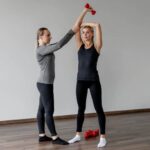Welcome to the Fitness Mag Plank Challenge. Are you ready to take your core strength and stability to new heights? Look no further, because we have the perfect solution for you. In this article, we will introduce you to a fun and effective way to strengthen your core – the Fitness Mag Plank Challenge. Whether you are a beginner or an experienced fitness enthusiast, this challenge is designed to push your limits and help you achieve a stronger, more toned midsection.
Planks are one of the most versatile and beneficial exercises for your core muscles. They not only target your abs, but also engage other major muscle groups in your body, including your back, shoulders, and legs. But what exactly makes planks so special? Stay tuned as we explore the numerous advantages of incorporating planks into your fitness routine.
Ever wondered why planks are hailed as one of the most effective exercises for strengthening your core? The science behind planks is fascinating. It’s all about engaging and activating multiple muscle groups simultaneously to create stability and improve overall body strength. Throughout this article, we will dive deep into the science behind planks and discuss how they target various muscles in your body.
But before we get into that, let’s start with the basics. In our step-by-step guide, we will provide you with detailed instructions on how to perform the perfect plank with proper form. We will also discuss different variations of planks that cater to all fitness levels, ensuring that anyone can participate in this challenge. So grab a mat and get ready to work on those abs.
So if you’re looking for an exciting fitness challenge that will transform your midsection while also engaging multiple muscle groups throughout your body, then stay with us as we delve into the Fitness Mag Plank Challenge. Get ready to sweat, feel empowered, and achieve remarkable results.
Understanding the Benefits of Planks
Planks are a simple yet powerful exercise that can provide a wide range of benefits to your fitness routine. Understanding these advantages can help you see why incorporating planks into your workouts is so beneficial.
Improved Core Strength and Stability
One of the main benefits of planks is their ability to strengthen your core muscles. The core encompasses the muscles in your abdomen, lower back, hips, and pelvis. By performing planks consistently, you can improve the strength and stability of these muscles. This increased core strength can have a positive impact on your posture, balance, and overall functional movements.
Additionally, planks engage deeper layers of abdominal muscles that are often neglected in traditional ab exercises. These deep core muscles play a crucial role in supporting and protecting your spine. Strengthening them through plank exercises can help alleviate back pain and reduce the risk of injuries.
Enhanced Overall Body Strength
While planks primarily target the core muscles, they also engage other major muscle groups in your body. When holding a plank position, you activate not only your abs but also your glutes (butt), quadriceps (thighs), deltoids (shoulders), and trapezius (upper back). This means that by incorporating planks into your fitness routine, you can achieve overall body strength improvement.
Stronger glutes can enhance hip stability and contribute to better alignment during various physical activities like walking or running. The engagement of shoulder muscles improves upper body strength, which is beneficial for any pushing or pulling movements. Plank exercises also activate multiple leg muscles simultaneously, leading to stronger legs overall.
Improved Posture and Spinal Health
Due to modern lifestyles involving prolonged periods of sitting or using handheld devices, many individuals suffer from poor posture and its related problems such as rounded shoulders or forward head posture. Planks encourage proper alignment by activating the muscles that are responsible for maintaining a healthy posture.
When performing planks, your back and shoulder muscles work together to support and stabilize your spine. As a result, the increased strength and stability of these muscles can help correct postural issues and reduce the risk of developing spinal conditions such as herniated discs or chronic lower back pain. Incorporating planks into your fitness routine can be an effective way to improve your posture and maintain better spinal health.
By understanding the benefits of incorporating planks into your fitness routine, you can see why they are such a valuable exercise for strengthening your core, improving overall body strength, enhancing posture, and maintaining spinal health. In the next section, we will dive deeper into the science behind planks to gain a better understanding of how they target multiple muscle groups and why they are so effective.
The Science Behind Planks
Planks are not just a popular exercise for strengthening the core, but they also provide a range of benefits for the entire body. Understanding the science behind planks can help you appreciate why they are so effective and why incorporating them into your fitness routine is highly beneficial.
When performing a plank, multiple muscle groups are engaged simultaneously. The primary muscles targeted include the rectus abdominis (the six-pack muscles), transverse abdominis (deep core muscles), obliques (side abdominal muscles), and erector spinae (back muscles). Additionally, planks also activate the glutes, hip flexors, quadriceps, hamstrings, and all the muscles surrounding the shoulder girdle. This comprehensive muscle engagement makes planks an incredibly efficient exercise for overall strength development.
Planks are particularly effective because they involve isometric contractions. Unlike dynamic exercises like squats or push-ups that involve movement and repetition, isometric exercises involve holding a static position. When you hold a plank position, your muscles engage without changing length or joint angles. This type of contraction strengthens not only the prime movers but also stabilizer muscles that are essential for maintaining good posture and preventing injuries in everyday activities.
Another reason why planks are scientifically proven to be effective is their ability to stimulate deep muscle fibers known as Type I muscle fibers. These slow-twitch muscle fibers play a crucial role in endurance and stability. By targeting these deep muscle fibers through prolonged holds in various plank variations, you can enhance your muscular endurance and overall functional fitness.
Step-by-Step Guide
Planks are a highly effective exercise that target and strengthen your core muscles. To perform the perfect plank, follow these step-by-step instructions:
- Start by positioning your body face-down on the floor.
- Place your forearms on the ground, ensuring that your elbows are directly under your shoulders.
- Extend your legs straight behind you, resting on the balls of your feet.
- Engage your core muscles by pulling your belly button towards your spine.
- Keep your body in a straight line from head to toe, avoiding any sagging or lifting of the hips or lower back.
- Hold this position for as long as you can while maintaining proper form.
For beginners, it may be helpful to start with modified planks by bending the knees and resting them on the ground instead of holding oneself up with toes. This modifies the exercise by reducing the amount of weight placed on the core muscles and making it easier to hold the position for an extended period.
As you become stronger and more comfortable with performing regular planks, you can gradually increase their difficulty by incorporating variations such as side planks or forearm planks with leg lifts. Side planks involve supporting yourself on one forearm while stacking one foot on top of another or elevating one leg in the air. Forearm planks with leg lifts require extending one leg straight out behind you while holding a plank position.
Remember that proper form is crucial when performing planks to prevent injury and maximize results. Avoid allowing your hips to sink or lift during the exercise as this can strain other muscles and reduce effectiveness.
By following these step-by-step instructions and incorporating variations suitable for your fitness level, you’ll be well on your way to mastering and reaping the benefits of planking in no time.
Maximizing Your Plank Routine
Planks are a great exercise for strengthening your core, but if you want to see faster results, it’s important to maximize your plank routine by increasing the intensity and duration of your workouts. Here are some tips and tricks to help you do just that:
- Increase Time: One way to maximize your plank routine is by gradually increasing the duration of your planks. Start by holding a plank for 30 seconds and gradually work your way up to one minute or longer. This will challenge your muscles more and help build endurance.
- Engage Your Muscles: To get the most out of your planks, make sure you’re engaging all of the muscles in your core, including your abs, back, hips, and glutes. Squeeze these muscles as tight as you can during each plank hold to increase the intensity of the exercise.
- Add Variations: Another way to maximize your plank routine is by incorporating different variations of planks into your workouts. Some options include side planks, single-leg planks, plank jacks, and forearm planks with leg lifts. These variations target different muscle groups and add variety to your routine.
- Use Props: If you’re looking for an extra challenge, consider using props during your plank workouts. Placing a stability ball or sliders under your feet can add instability and engage more muscles. You can also try elevating your feet on a bench or step to increase the difficulty of the exercise.
By following these tips and tricks, you can take your plank routine to the next level and achieve faster results in strengthening your core muscles. Remember to start slowly and gradually increase the intensity over time to avoid injury. Stay consistent with your workouts and track your progress to stay motivated along the way.
| Tip | Description |
|---|---|
| Increase Time | Gradually increase the duration of your plank holds to challenge your muscles and build endurance. |
| Engage Your Muscles | Squeeze your abs, back, hips, and glutes as tight as you can during each plank hold to increase intensity. |
| Add Variations | Incorporate different types of planks, such as side planks or single-leg planks, to target different muscle groups and add variety. |
| Use Props | Try using stability balls, sliders, or elevating your feet on a bench to add extra challenge and engage more muscles. |
Keeping it Fun
Planks are an effective exercise for strengthening the core muscles, but they can become monotonous if done repetitively. To keep your fitness routine interesting and enjoyable, it’s important to find creative and engaging ways to spice up your plank challenge. This section will provide ideas for incorporating partner planks and plank variations into your workout.
Partner planks are a fun and interactive way to make your plank challenge more exciting. Instead of doing planks alone, you can invite a friend or family member to join you.
One popular partner plank variation is the high five plank, where you both assume the plank position facing each other and reach out with one hand to give each other a high five. This adds an element of coordination and teamwork to your workout, making it more enjoyable and motivating.
Another way to make your plank challenge more interesting is by incorporating different variations of the standard plank exercise. There are many ways to modify the traditional plank, such as side planks, forearm planks, or stability ball planks. By introducing these variations into your routine, you can target different muscle groups and add variety to your workout.
You can also try dynamic planks, which involve moving parts of your body while holding the plank position. This not only challenges your core muscles but also increases overall body strength and stability.
In addition to partner planks and variations, there are other creative ways to keep your plank challenge fun. You can set mini goals for yourself, such as holding a plank for an extra 10 seconds each day or trying a new variation every week. Joining online fitness communities or challenge groups can also provide motivation and support from like-minded individuals who are on a similar fitness journey.
By keeping your plank challenge fun and engaging, you’ll be more likely to stick with it in the long run and achieve better results. Remember that consistency is key when it comes to any fitness routine, so finding ways to enjoy what you’re doing is crucial for maintaining motivation and staying on track.
Tracking and Progressing
Tracking and Progressing: The Importance of Tracking Your Plank Challenge Progress and How to Gradually Increase Difficulty Over Time
Why Tracking Is Important
Tracking your progress during the Fitness Mag Plank Challenge is essential for several reasons. First, it allows you to see how far you’ve come and celebrate your achievements along the way. Seeing tangible evidence of your hard work can provide a significant boost in motivation and keep you committed to completing the challenge.
Moreover, tracking your plank challenge progress helps you set realistic goals. By recording the duration or number of repetitions you can perform each day, you can gradually increase the difficulty over time in a structured and safe manner. This gradual increase ensures that you continue challenging yourself without risking injury or burnout.
How to Track Your Plank Challenge Progress
To track your progress effectively, start by creating a simple chart or spreadsheet where you can record important details such as date, duration/repetitions, and any additional notes. This will allow you not only to monitor how long you can hold a plank but also track improvements in form and technique.
Consider using a fitness app or wearable device that specializes in tracking workouts. These tools often come with built-in timers and even offer visual representations of your progress over time. Additionally, they may provide personalized recommendations based on your current fitness level, helping you optimize your plank routine.
Gradually Increasing Difficulty
As the saying goes, “No pain, no gain.” While planks may be challenging at first, gradually increasing difficulty is key to achieving optimal results throughout the Fitness Mag Plank Challenge. Here are some strategies to help you level up:
- Longer Duration: Start by holding a basic plank for 30 seconds and aim to increase it by 5-10 seconds every few days until you reach your target time.
- Adding Variations: Once you’ve mastered the basic plank, incorporate different variations to increase intensity. Side planks, plank jacks, and plank rotations engage additional muscle groups and provide a more comprehensive workout.
- Unstable Surfaces: Planks can be performed on surfaces like stability balls or Bosu balls to make the exercise more challenging and engage your core even further.
Remember, consistency is key when it comes to progressing in the Fitness Mag Plank Challenge. Keep your tracking method handy and aim to push yourself just beyond your comfort zone each time. With dedication and patience, you’ll be amazed at how far you can go.
Real-life Success Stories
When it comes to fitness challenges, hearing about real-life success stories can be incredibly motivating. The Fitness Mag Plank Challenge has helped countless individuals transform their bodies and achieve remarkable results. From weight loss to increased core strength, these inspiring stories prove that committing to the plank challenge can lead to significant changes.
One success story comes from Lisa, a busy mother of two who struggled with losing the baby weight. She decided to take on the Fitness Mag Plank Challenge as a way to tone her core and get back into shape. Starting with modified planks on her knees, she gradually built up her strength and stamina over time.
After completing the 30-day challenge, Lisa not only lost inches from her waist but also gained newfound confidence in herself. She continues to incorporate planks into her daily routine and has become an inspiration for other moms looking to reclaim their pre-pregnancy bodies.
Another inspiring success story is Jason’s journey with the Fitness Mag Plank Challenge. As someone who had always struggled with maintaining consistency in his workout routine, he was skeptical about whether the plank challenge would make a difference. However, after seeing the transformation of others, he decided to give it a try.
Jason started with basic planks and gradually increased his endurance each day. Not only did he notice improved core strength, but he also experienced reduced lower back pain-a result he had never expected. Encouraged by these positive changes, Jason now incorporates planks into his weekly workouts as a permanent addition to his fitness regimen.
These real-life success stories show just how effective the Fitness Mag Plank Challenge can be in transforming your body and achieving remarkable results. Whether you’re looking to lose weight, strengthen your core, or improve your overall fitness level, committing to this challenge can lead to incredible changes. So if you’re ready to take on the planking challenge, remember that these inspiring stories are proof that with dedication and perseverance, you can achieve your fitness goals.
Maintaining Motivation
Maintaining motivation is key to completing any fitness challenge, including the Fitness Mag Plank Challenge. Here are some strategies and techniques that can help you stay motivated and committed throughout the duration of the challenge.
Firstly, it is important to set clear goals for yourself at the beginning of the challenge. Determine what you want to achieve by completing the plank challenge, whether it’s strengthening your core, improving your overall fitness, or simply challenging yourself. Write down your goals and keep them somewhere visible, such as on a refrigerator or a vision board. This will serve as a constant reminder of why you started and can help keep you motivated.
Additionally, find an accountability partner or join a support group. Sharing your journey with someone who has similar goals can provide encouragement and support when motivation starts to wane. You can check-in with each other regularly, share progress updates, and celebrate milestones together. If you prefer a more community-based approach, consider joining online forums or fitness communities where you can connect with like-minded individuals who are also participating in the challenge.
Another effective strategy is to mix up your routine and add variety to your plank workouts. Doing the same exercise over and over again can become monotonous and lead to boredom. To combat this, incorporate different plank variations into your routine or try new exercises that target similar muscle groups. Not only will this make your workouts more interesting, but it will also prevent plateauing and help stimulate further progress.
Lastly, reward yourself along the way for reaching small milestones or achieving personal bests during the challenge. Set up a system of rewards that align with your interests and passions outside of fitness. Whether it’s treating yourself to a spa day, indulging in a favorite meal, or buying new workout gear, these little rewards can provide extra motivation to push through when things get tough.
By utilizing these strategies for maintaining motivation throughout the Fitness Mag Plank Challenge, you’ll increase your chances of successfully completing the challenge and achieving your desired results. Remember that motivation may fluctuate, but with perseverance and a positive mindset, you can overcome any obstacles that come your way.
FAQs and Expert Tips
In conclusion, the Fitness Mag Plank Challenge offers a fun and effective way to strengthen your core and achieve remarkable results. By incorporating planks into your fitness routine, you can experience numerous benefits such as improved posture, increased stability, and enhanced overall strength. The science behind planks lies in their ability to target multiple muscle groups simultaneously, making them one of the most efficient exercises for strengthening the core.
To ensure success during the plank challenge, it is important to follow a step-by-step guide that provides proper form and variations for all fitness levels. This will help you perform the perfect plank and avoid common pitfalls that may lead to injuries or ineffective workouts.
Furthermore, maximizing your plank routine involves increasing intensity and duration over time for faster results. By gradually pushing your limits and challenging yourself, you can continue to improve and see progress throughout the challenge.
To keep things fun and engaging, try incorporating partner planks or experiment with different plank variations. This not only adds variety to your workouts but also helps prevent boredom or plateauing. Tracking your progress is crucial in staying motivated and committed throughout the challenge. Whether it’s through photos, measurements, or workout logs, seeing how far you’ve come can be incredibly inspiring.
Finally, maintaining motivation is key to completing the Fitness Mag Plank Challenge from start to finish. Strategies such as setting goals, finding an accountability buddy, or participating in online communities can all help keep you motivated along your fitness journey. Additionally, seeking expert advice through FAQs and expert tips can provide valuable insight into common questions or concerns that may arise during the challenge.
Overall, by following these expert tips and addressing common questions surrounding the Fitness Mag Plank Challenge, you are setting yourself up for success in achieving your fitness goals. So embrace the challenge with enthusiasm And remember-consistency is key.

Passionate about providing useful information to anyone with an interest in the field of Personal Training, I strive to pass on to our readers quality information and to answer any questions about Personal Trainers, the work they do and how to become one.





